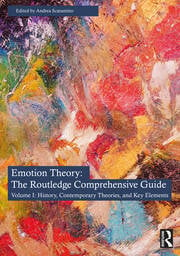ラウトレッジ版 感情の理論:包括的ガイド(全2巻)
Emotion Theory: the Routledge Comprehensive Guide

Editor: Andrea Scarantino, Professor of Philosophy at Georgia State University
2024:07 2 vols. 1,288 p. ISBN 978-1-032-73187-2 (Routledge) -GB-
☆期間限定特価20% OFF GBP 300(※2024/12/25ご注文まで有効)
Web販売価格:税込¥63,363 / 標準価格:税込¥88,110
通常価格 GBP 375
Web販売価格:税込¥79,203 / 標準価格:税込¥110,137
*セール期間が終了次第、通常価格が適用されます。
*2024年8月26日時点の価格です。実際の価格は、為替レートや出版社の都合により変動いたしますので、最新の価格は以下オンラインストアリンクをご参照ください。
*Web販売価格は、紀伊國屋書店BookWeb Proでご注文され、付帯作業を伴わない納品を行い、弊社標準書式による請求書を発行し遅滞なくお支払いただく場合、あるいは、クレジットカードでお支払いいただく場合に適用される販売価格です。
概要
感情(情動)は、人間の生になくてはならないものであるにもかかわらず、長年、哲学においても自然科学においても、閑却されがちな対象でした。近年、人間知性において、理性だけではなく感情(情動)も劣らず大きな役割を果たしていることが広く認められ、政治や社会的な意思決定においても議論の的となっています。「感情史」の隆盛など、近年の人文・社会系の学問全般で「感情(情動)」が注目を集めている所以です。
本書は、学際的な「感情の理論」の歴史と現在を見わたす、初の包括的なレファレンスとして画期的です。全2巻にわたって、哲学、古典学、心理学、生物学、精神医学、神経科学、社会学といった各分野で活躍する感情の理論家101名が最新の視座から書き下ろした全62章を収録し、文字通り包括的なガイドとなりました。古代ギリシア・ローマから現在までの感情の思想史を網羅しつつ、今日の認知科学・情動科学の展開に至り、「憎悪」「欲望」「甘え」「ストレス」などの個別の感情についてもそれぞれ詳しく論じています。
哲学・心理学はもちろん心がかかわる文理を越える学問全般に必携のリソースとして、おすすめいたします。
価格照会・ご購入
※本件についてのお問い合わせ、お見積りについては、最寄りの紀伊國屋書店営業所もしくはこちらのお問い合わせフォームまでご連絡ください。
本書の構成
第1巻:歴史・理論的選択肢・課題
第1部:感情の理論の歴史(全10章)
第2部:感情の理論の現在(全10章)
第3部:感情の理論の基礎(全7章)
第2巻:個別の感情の理論、事例研究、主要な課題
第4部:個別の感情の理論の現在(全22章)
第5部:感情の理論が直面する課題(全13章)(感情を催す特定の要素/感情と他の心的構造との関係/子ども・動物・集団の感情/感情の規範的側面)
収録内容明細
Volume I: History, Theoretical Options, Challenges
Introduction to Volume I: History, Theoretical Options, Challenges
Andrea Scarantino
Part I: History of Emotion Theory
- Emotion Theory in Ancient Greece and Rome
Pia Campeggiani and David Konstan
- Emotion Theory in Ancient and Classical India, from 500 BCE to 1200 CE
Maria Heim
- Emotion Theory in Early and Medieval China, from 500 BCE to 1200 CE
Virag Curie
- Emotion Theory in the Middle Ages
Simo Knuuttila
- Emotion Theory in the Renaissance
Sabrina Ebbersmeyer
- Emotion Theory in the 17thCentury
Lisa Shapiro
- Emotion Theory in the 18thCentury
Eric Wilson
- Emotion Theory in the 19th Century at the Rise of Scientific Psychology
Rainer Reisenzein
- Emotion Theory in the 19thand 20thCentury Phenomenological Tradition
Ingrid Vendrell-Ferran
- Emotion Theory in the First Half of the 20th Century
Anna Kennedy and Keith Oatley
Part II: Contemporary Theories of Emotions
- An Overview of Contemporary Theories of Emotions in Philosophy
Michael Brady
- An Overview of Contemporary Theories of Emotions in Psychology
Agnes Moors
- An Overview of Contemporary Theories of Emotions in Neuroscience
Stephan Hamann
- An Overview of Contemporary Theories of Emotions in Sociology
Kathryn Lively
- Basic and Discrete Emotion Theories
Michelle Shiota
- Appraisal Theories of Emotions
Phoebe Ellsworth
- Constructionist Theories of Emotion in Psychology and Neuroscience
Lisa Barrett and Tsiona Lida
- Social Constructionist Theories of Emotions
Batja Mesquita and Brian Parkinson
- Cognitivist Theories of Emotions in Philosophy and Affective Science
Bennett Helm
- Motivational Theories of Emotions in Philosophy and Affective Science
Andrea Scarantino
Part III: The Elements of Emotion Theory
- Are Emotions Events, Processes, Mechanisms or Dispositions?
Hichem Naar
- Is Emotion Physiology More Compatible with Discrete, Dimensional or Appraisal Accounts?
Bruce Friedman and Julian Thayer
- Can Brain Data Be Used to Arbitrate Between Emotion Theories?
Philip Kragel, David Sander, Kevin LaBar
- What Do Nonverbal Expressions Tell Us About Emotion?
Disa Sauter and Jim Russell
- Which Emotional Behaviors are Actions?
Jean Moritz Müller and Hong Yu Wong
- Emotional Experience: What Is It and What Is It For?
Richard Dub
- How Should We Understand Valence, Arousal and Their Relation?
Giovanna Colombetti and Peter Kuppens
Volume II: Theories of Specific Emotions, a Master Table of Case Studies and Some Key Challenges
Introduction to Volume II: Theories of Specific Emotions, a Master Table of Case Studies and Some Key Challenges
Andrea Scarantino
Part IV: Contemporary Theories of Specific Emotions
- Amusement
Ruch Williband and Jenny Hofmann
- Anger and Interpersonal Dislike Ira Roseman
- Compassion, Gratitude, and Awe
Jennifer Stellar and Amie Gordon
- Contempt and Hate
Agneta Fischer
- Desire
Timothy Schroeder
- Disgust
Joshua Tybur
- Empathy and Sympathy
Karsten Stueber
- Envy and Jealousy
Kristján Kristjánsson
- Fear
Temidayo Orederu, Veronica Lennon, Bram Vervliet, and Daniela Schiller
- Guilt, Embarassment and Shame
Jerry Parrott
- Happiness/Subjective Well-Being
Ed Diener and Jing-Ha Sim
- Hope and Enthusiasm/Excitement
Michael Milona, Hunter Threadgill and Philip Gable
- Interest
Dustin B. Thoman and Christina C. Leal
- Love
Sue Carter and Elaine Hatfield
- Lust/Sexual Desire
Frederick Toates
- Pain and Pleasure
Murat Aydede
- Pride
Jessica Tracy, Aaron C. Weidman, and Eric Mercadante
- Regret
Marcel Zeelenberg
- Sadness and Depression Reuma Gadassi-Polack, Matthias Siemer and Jutta Joormann
- Stress
Robert-Paul Juster and Sonia Lupien
- Surprise
Gernot Horstmann and Achim Schuetzwohl
- Amae, Shadenfreude, Saudade
Michael Boiger, Yukiko Uchida and Igor de Almeida
Part V: Some Major Theoretical Challenges Facing Emotion Theory
Special Elicitors of Emotions
- How Does Music Elicit Emotions?
Robina Day and William Forde Thompson
- How Does Fiction Elicit Emotions?
Florian Cova and Stacie Friend
Emotions and their Relations to Other Elements of Mental Architecture
- How Do Emotions Affect Decision Making?
Jennifer Lerner, Charlie Dorison and Joowon Kim
- How Can Emotions Be Regulated?
Andero Uusberg, Helen Uusberg, and James Gross
- How Do Emotions Differ from Moods?
Carolyn Price
- How Are Emotions and the Self Related?
Mauro Rossi and Christine Tappolet
Emotions in Children, Animals and Groups
- How Do Emotions Develop in Children? Linda Camras
- Do Animals Have Emotions?
Elizabeth S. Paul, Vikki Neville and Michael T. Mendl
- Can Groups Have Collective Emotions?
Mikko Salmela
Normative Aspects of Emotions
- What Makes Emotions Appropriate or Inappropriate to Their Objects?
Justin D’Arms
- How Do Emotions Become Dysfunctional?
Kathy Dixon-Gordon and Lauren Haliczer
- What Roles Do Emotions Play in Morality?
Antti Kauppinen
- Can Emotions Provide Knowledge, Justification or Understanding?
Julien Deonna and Fabrice Teroni
(学術洋書部)